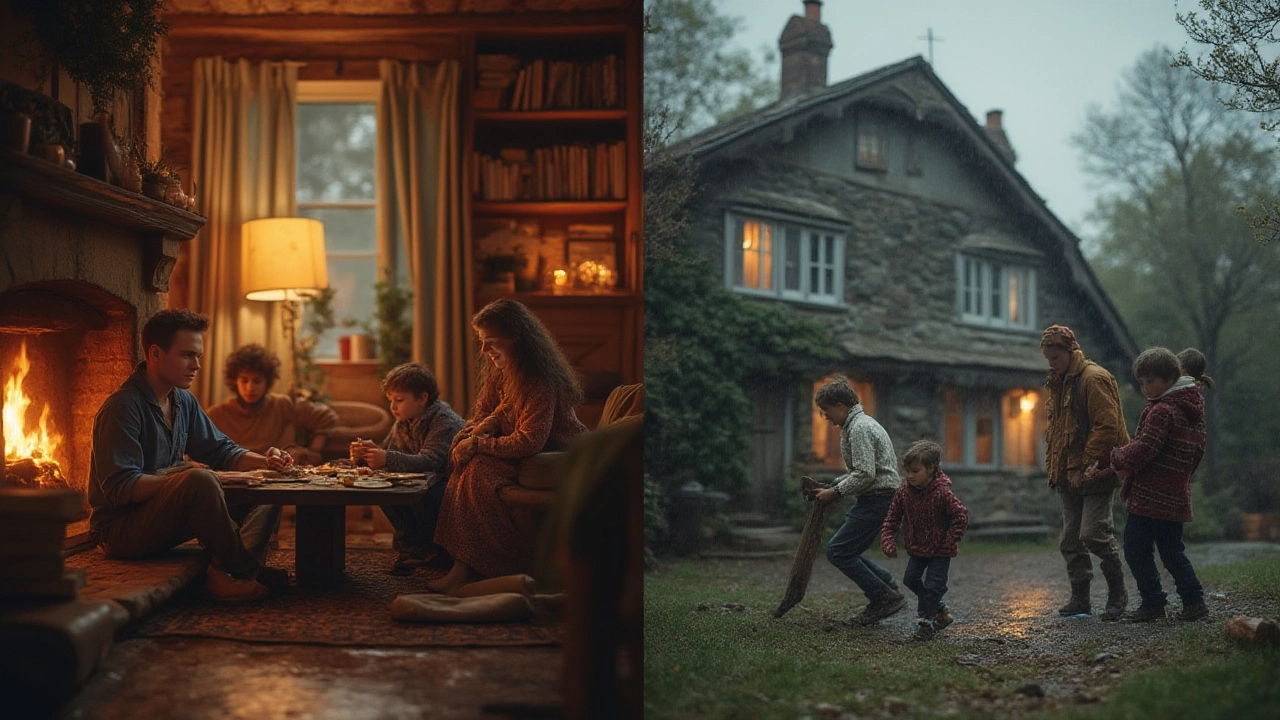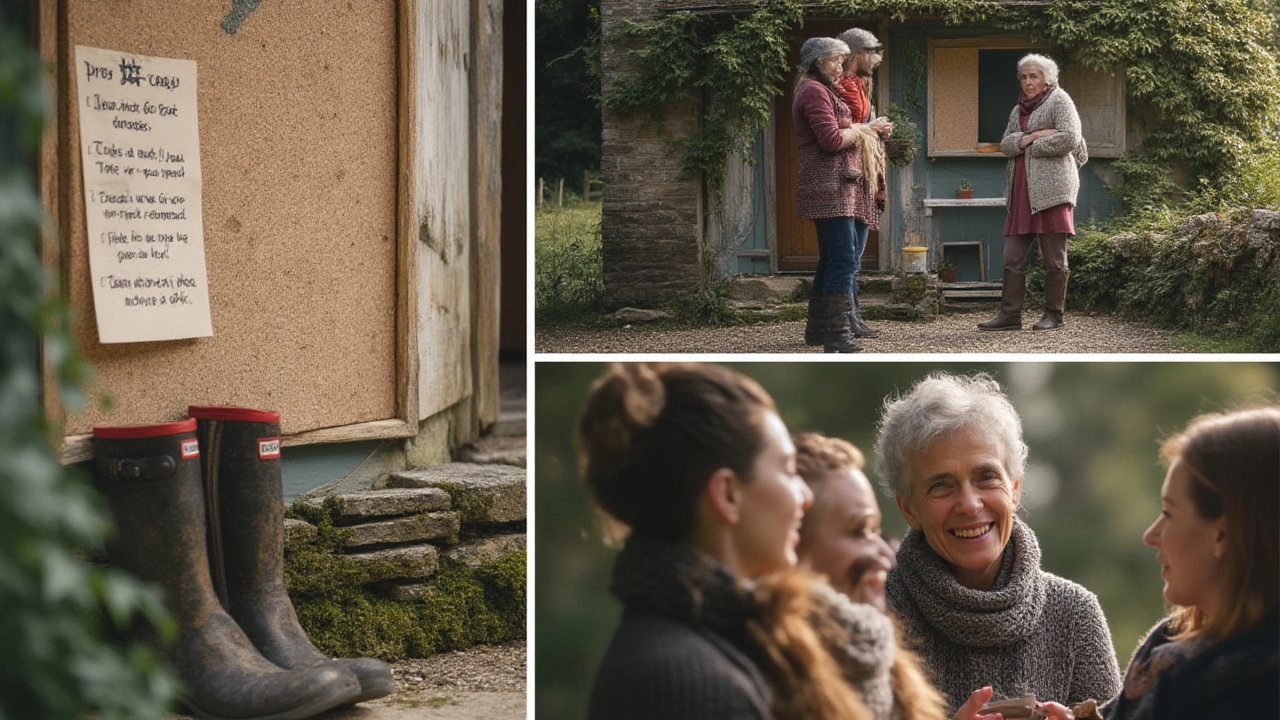Cottages have always tugged at us in a way that few other homes can. You know the scene: worn stone walls tucked under a wildflower roof, smoke curling from a chimney, the air carrying smells of moss and wood. For some, it’s an Instagrammable escape. For others, that humble cottage is a ticket out of traffic, concrete, and 24/7 noise. But here’s where things get interesting—balancing the dream with real life can get, well, complicated. Is moving into a cottage as blissful as a watercolor painting, or are there some very real snarls woven into those rose-covered walls? Let’s untangle the honest, practical, and surprisingly gritty reality of cottage living, so you’ll know whether that fairy tale is calling you—or if it’s best enjoyed just on holiday.
Why Are We All Obsessed With Cottages?
Scrolling through property apps these days, it’s impossible to miss the explosion of cottage listings. A market survey from the UK in 2024 showed a 27% increase in searches for rural cottages compared to just two years ago. It’s not just romantic nostalgia talking; people want to step away from city stress, and the cottage is the ultimate symbol of that unplugged lifestyle.
What makes cottages so compelling? A lot of people say it’s about the coziness—think wood stoves, thick blankets, and the quiet hum of crickets at twilight. Instagram and TikTok have only fueled the fire. Thousands use tags like #cottagecore and #simpleliving, showing morning coffees in tiny kitchens and handpicked bouquets. This ‘cottagecore’ aesthetic has made the simple life look more alluring than ever. But there’s more beneath the surface. For many, it’s the need for space, autonomy, connection to nature, and—ironically—a kind of luxury in living small.
The pandemic flipped how people value home. More than half of cottage buyers who responded to a 2023 real estate survey said they wanted "more breathing space and less anxiety," and found it easier to picture themselves in the countryside after remote work became normal. It’s never just about the cottage’s looks. The deeper motivation is peace of mind and a life of meaning, not just endless hustle.
Let’s be honest: there’s nostalgia at work here. Many of us are hunting for a time we never actually lived, yearning for slower mornings and honest manual labor like chopping firewood or planting a herb garden. The allure is old-fashioned, but the desire is real, especially when city life gets to be too much.
Then there’s the community draw. In rural settings, knowing your neighbors isn’t just a cliché; it genuinely happens more often. Whether it’s a monthly farmer’s market or helping someone repair a roof after a storm, you get woven into the fabric of the place. Statistics from rural England found that 72% of cottage-dwellers said they felt a stronger sense of belonging compared to their old city lives.
But it’s not all tea and roses. The reality check comes quickly. Let’s look at what daily cottage life is really like, peeling back the Instagram filter.
The Unexpected Realities of Daily Cottage Life
Ask anyone who’s swapped city lights for cottage nights, and you’ll find out it’s not always wildflowers and whistling kettles. Start with the basics—heating. Most old cottages are notorious for being hard to heat. Picture single-pane windows that refuse to keep the wind out, stone walls that hold cold like a sponge, and creaky floorboards that seem to amplify every chilly gust.
A 2024 Home Efficiency study in Scotland found that rural cottages use up to 35% more energy to stay warm than modern apartments of the same size. That means higher bills, unless you’re up for major insulation upgrades, which can get pricey (think £8,000 to £15,000 for proper wall and roof insulation in the UK). If you want to heat with wood, prepare for the physical demands—hauling logs, chopping kindling. It’s not a set-and-forget kind of warmth.
Then there are maintenance surprises. Leaky roofs, aging chimneys, and mysterious drafts are part and parcel of older cottages. A real issue found by The National Trust in 2023: around 28% of cottages listed as "move-in ready" ended up needing urgent repairs within the first year. That’s a fixer-upper reality most brochures skip.
Water and utilities can also be a wake-up call. Many rural cottages depend on well water, septic tanks, or shared community systems. In dry spells, wells run low. In heavy rain, septic tanks can be troublesome. Modern comforts aren’t always so, well, modern.
Let’s talk internet. If your job depends on strong wi-fi, this could be a dealbreaker. Even in 2025, more than 19% of rural UK postcodes still have spotty coverage. Some cottage dwellers solve this with boosters or satellite, but speeds can vary and setup costs add up quick.
| Feature | City Apartment | Traditional Cottage |
|---|---|---|
| Average Heating Cost/Month (£) | 70 | 110 |
| Maintenance Needs/Year | Low | High |
| Wi-fi Speed (Mbps) | 80+ | 10-30 |
| Nearest Hospital (min drive) | 10 | 35 |
| Access to Public Transport | Excellent | Limited/None |
Getting snowed in is another classic rural moment. Sure, it sounds romantic to curl up with a book, but not when you need groceries or a prescription and the roads are blocked. Rural life rewards good planning—for everything from stashing tinned beans, to winter tyres, to learning how to unblock a gutter yourself.
It’s not all on the downside, though. The flipside is actual silence—nights when the only noise is an owl, days spent in nature, and a chance to know your patch of land in a way that never happens in a two-up, two-down rental.

You, Nature, and the Neighbors: The Cottage Community Experience
Here’s where cottage life shines. If you crave space for a kitchen garden, want a dog bigger than your couch, or always dreamed of chickens, a cottage out in the country delivers all three. Having your own bit of earth means you can experiment—try growing asparagus, mastering compost, or building a shed. Fresh air and green space are proven mood boosters. Studies in 2023 by the European Environmental Agency reported a 22% drop in reported anxiety for adults who switched to rural living, largely due to increased time outdoors and better sleep.
But even paradise needs a social plan. Rural villages can be tight-knit—or a bit slow to welcome outsiders. Small communities mean everyone knows everyone. Expect gossip, but also neighbors who check in, swap eggs for fruit, and genuinely have your back in emergencies.
If you want more connection, throw yourself into local events. Villages often hold regular get-togethers—anything from summer fêtes to apple harvests. Many newcomers find joining local clubs or volunteering at the primary school or community shop to be the best way to break the ice. The key is to pitch in, not just pass through.
Families often ask about schooling. Many rural schools are small and friendly, with lower student-teacher ratios. But teens might find it tough—longer commutes to bigger schools, fewer after-school activities, and limited public transit options. In fact, a 2024 survey in Wales found the average rural secondary school student travels 17 miles a day, compared to just 3 miles for their city counterparts. So, be ready for real logistics if you have kids.
There are new routines too. Trips to the shop become weekly outings, not daily dashes. Being self-reliant is almost a point of pride; you’ll find yourself picking up DIY tricks, like mending fences or fixing leaky taps. Convenience is traded for satisfaction, which, for many, is the whole point.
But, fair warning: rural areas still lag behind on diversity and inclusion compared to cities. If you’re looking for vibrant nightlife, global food, or lots of cultural events on your doorstep, this isn’t quite it. But for those seeking quiet, community, and deeper traditions, it’s hard to beat.
The Financials: Can You Really Afford Cottage Life?
Dreams are great, but budgets matter. On the face of it, rural cottages often cost less than city flats. Property data in 2025 shows a classic two-bedroom cottage in Devon lists at around £325,000, compared to £520,000 for a similar-sized London flat. Sounds good—and it is, if you’re buying outright. But don’t forget the hidden costs.
Repairs add up quickly. Expect to set aside at least 1% of your home’s purchase price per year for maintenance. And prices for tradespeople can be higher in rural areas—fewer options, longer travel. Roof repairs, new septic tanks, or even rewiring can mean sudden, four-figure bills.
Insurance is another surprise. Some cottage buyers face premiums 20-30% higher due to risk factors like thatched roofs, distance from fire stations, or flooding potential. If you’re dealing with listed buildings—properties with historic protections—expect extra red tape (and higher costs) for almost any change you want to make.
The joys of growing your own food or keeping chickens can offset your grocery bills a bit, but rarely enough to balance out maintenance spikes. Still, people do find creative solutions: co-owning big equipment with neighbors, bartering skills locally, even crowd-funding repairs for historic properties.
Commuting (if you need to go into the city) can eat up savings. Rural bus services are often reduced or gone, so a car is nearly always essential. That also means higher fuel bills, more servicing, and dealing with rough winter roads. But if you work from home, the maths starts looking much better—just make sure your job is flexible or robust against rural connectivity hiccups.
Let’s not forget energy bills. Modernizing old stone cottages for energy efficiency isn’t cheap, but it pays off. Think of investing in solar panels or ground-source heat pumps. A 2024 grant scheme in Scotland provides up to £7,500 for renewable energy installations—so look out for similar support where you are.
If you dream of sustainability, many rural buyers convert their cottages into eco-friendly havens. Rainwater harvesting, compost toilets, permaculture gardens, even switching to off-grid solar. These efforts can eventually ‘pay you back’ in cheaper utility bills (and satisfaction), but start-up costs are real.

Could Cottage Living Be Right for You? Tips and Honest Advice
If you’re itching to try cottage living, start with some honest questions. Are you up for rolling your sleeves up, getting dirty, and learning things most people now outsource? Do you love quiet more than nightlife? Can you handle the slower pace, maybe even find joy in it?
Here are a few real-world tips from cottage-dwellers who made the leap in 2024 and 2025:
- Investigate the area closely. Visit at different times (especially in winter). Roads, shops, and even local friendliness can change dramatically once tourist season ends.
- Check phone signal and broadband speeds, not just with maps, but with your own devices. Some places look fine on paper but drop out inside thick stone walls.
- Make a practical list of essentials: How far is the nearest GP? What’s your evacuation plan in storms or floods? Extreme weather is a growing reality, even in the UK.
- Budget for annual repair costs. Talk to neighbors about typical outlays, especially after the first hard winter.
- Expect to drive a lot. Factor in fuel, servicing, and time lost if remote work isn’t feasible for you.
- Invest in good boots, layers, torches, and a toolbox. You’ll use them all.
- Don’t romanticize total isolation. Even introverts can feel alone—find out how to stay connected (local clubs, online groups, neighborhood WhatsApps, etc).
- Be ready for wildlife. Hedgerows and fields mean foxes, deer, and sometimes unwelcome visitors (mice, bats, insects). Secure bins and find humane solutions.
Mistakes will happen—it’s normal. Most cottage owners admit to a few sobering surprises their first year, from a collapsed pipe to a vanishing delivery, but few would swap back for city stress afterwards. The sense of achievement—fixing something yourself, growing your own tomatoes, waking to birdsong—replaces convenience. If that trade sounds good, cottage living might just be for you.
So, is living in a cottage a good idea? Only you can answer that. It’s not everyone’s cup of herbal tea, but if you crave space, silence, and a life woven around nature, it just might be the adventure you need.
